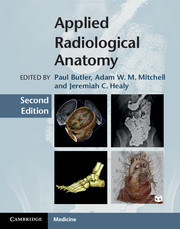Book contents
- Frontmatter
- Contents
- List of contributors
- Section 1 Central Nervous System
- Section 2 Thorax, Abdomen and Pelvis
- Chapter 6 The chest
- Chapter 7 The heart and great vessels
- Chapter 8 The breast
- Chapter 9 The anterior abdominal wall and peritoneum
- Chapter 10 The abdomen and retroperitoneum
- Chapter 11 The gastrointestinal tract
- Chapter 12 The kidney and adrenal gland
- Chapter 13 The male pelvis
- Chapter 14 The female pelvis
- Section 3 Upper and Lower Limb
- Section 4 Obstetrics and Neonatology
- Index
Chapter 7 - The heart and great vessels
from Section 2 - Thorax, Abdomen and Pelvis
Published online by Cambridge University Press: 05 November 2012
- Frontmatter
- Contents
- List of contributors
- Section 1 Central Nervous System
- Section 2 Thorax, Abdomen and Pelvis
- Chapter 6 The chest
- Chapter 7 The heart and great vessels
- Chapter 8 The breast
- Chapter 9 The anterior abdominal wall and peritoneum
- Chapter 10 The abdomen and retroperitoneum
- Chapter 11 The gastrointestinal tract
- Chapter 12 The kidney and adrenal gland
- Chapter 13 The male pelvis
- Chapter 14 The female pelvis
- Section 3 Upper and Lower Limb
- Section 4 Obstetrics and Neonatology
- Index
Summary
Embryology
Heart and pericardium
The primitive heart forms by the fusion of two parallel tubes to produce a single pulsating tube.
Grooves then develop along the tube to demarcate the sinus venosus, atrium, ventricle, and bulbus cordis (Fig. 7.1).
Venous blood, from the umbilical and vitelline (yolk sac) veins drains into the sinus venosus.
The arterial blood is pumped out through the truncus arteriosus.
The dorsal and ventral endocardial cushions separate the single atrial cavity from the single ventricle and divide the common atrioventricular opening into a right (tricuspid) and left (mitral) orifice.
In the fully developed heart the atria and great veins lie posterior to the ventricles and roots of the great arteries.
A detailed account of the division of the single primitive atrium and ventricle is beyond the scope of this book.
Aortic arch and derivatives
Six pairs of vascular arches arise from the truncus arteriosus. On either side these arteries join to form the longitudinally placed dorsal aortae. The dorsal aortae fuse distally to form the descending aorta.
The first, second and fifth arches essentially disappear.
The third arch becomes the common carotid artery on either side.
The right fourth arch becomes the brachiocephalic trunk and the right subclavian artery.
The left fourth arch forms the aortic arch, gives off the left subclavian artery before linking with the descending aorta.
The proximal parts of the sixth aortic arches persist as the right and left pulmonary arteries. The distal part of the right sixth aortic arch degenerates. The distal part of the left sixth aortic arch retains its connection to the dorsal aorta to form the ductus arteriosus (Fig. 7.2).
- Type
- Chapter
- Information
- Applied Radiological Anatomy , pp. 109 - 125Publisher: Cambridge University PressPrint publication year: 2012

